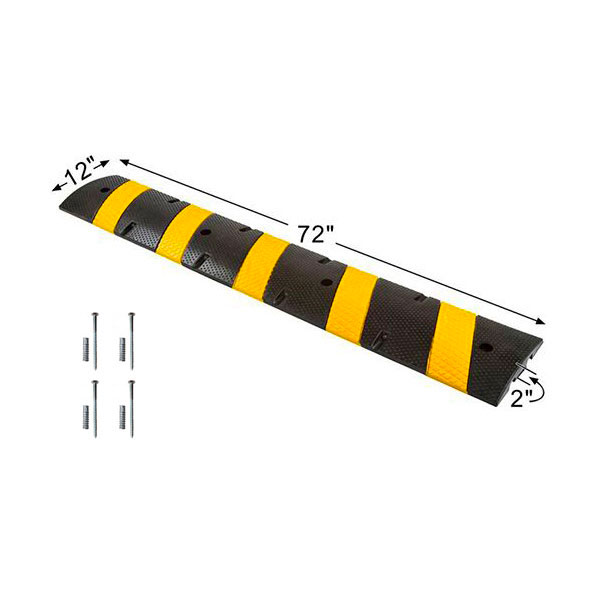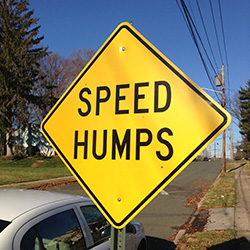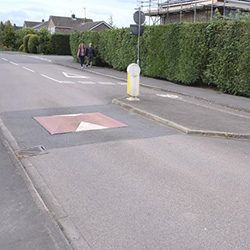
The Benefits of Installing Speed Bumps
Reducing Speeding and Accidents
Speed bumps are an effective way to reduce speeding and accidents in various industries. For instance, in parking lots, speed bumps can help prevent collisions between vehicles and pedestrians. In industrial areas, speed bumps can reduce the risk of accidents involving heavy machinery and equipment. In residential areas, speed bumps can help prevent accidents involving children and pets. By slowing down traffic, speed bumps can also reduce the severity of accidents and minimize property damage. Overall, installing speed bumps can help create a safer environment for everyone.
Improving Pedestrian Safety
Speed bumps are an effective way to improve pedestrian safety in areas with high foot traffic. By slowing down vehicles, speed bumps give pedestrians more time to cross the road safely. This is particularly important in areas such as school zones, parks, and residential areas where children and elderly people are likely to be present. Installing speed bumps can also help to reduce the risk of accidents caused by speeding drivers, making the area safer for everyone. In addition, speed bumps can encourage drivers to be more aware of their surroundings and to drive more cautiously, which can further improve pedestrian safety.
Encouraging Safe Driving Habits
Encouraging safe driving habits is crucial in any industry that involves vehicles. Installing speed bumps can help to remind drivers to slow down and drive carefully, reducing the risk of accidents and injuries. By creating a safer environment for both drivers and pedestrians, businesses can also reduce their liability and insurance costs. Additionally, promoting safe driving habits can improve employee morale and productivity, as workers feel more secure and confident in their workplace. Overall, installing speed bumps is a simple yet effective way to encourage safe driving habits and create a safer, more productive workplace.
Industries That Can Benefit from Installing Speed Bumps
Schools and Universities
Schools and universities are another industry that can greatly benefit from the installation of speed bumps. With the safety of students and faculty being a top priority, speed bumps can help to slow down drivers and prevent accidents in school zones and parking lots. Additionally, speed bumps can also help to reduce the risk of liability for the school or university in the event of an accident. By installing speed bumps, schools and universities can create a safer environment for everyone on campus.
Residential Communities
Residential communities are one of the top industries that can benefit from installing speed bumps. Speed bumps can help to reduce the speed of vehicles in residential areas, making them safer for pedestrians and children playing outside. They can also help to reduce noise pollution and improve the overall quality of life for residents. Additionally, speed bumps can help to deter speeding drivers and reduce the risk of accidents, which can be especially important in areas with high foot traffic or limited visibility. Overall, installing speed bumps in residential communities can be a simple and effective way to improve safety and quality of life for residents.
Hospitals and Healthcare Facilities
Hospitals and healthcare facilities are places where safety and security are of utmost importance. Installing speed bumps in these areas can help reduce the risk of accidents and injuries caused by speeding vehicles. Speed bumps can also help regulate traffic flow and ensure that emergency vehicles have clear access to the facility. Additionally, speed bumps can help prevent unauthorized vehicles from entering restricted areas, ensuring the safety and privacy of patients and staff. Overall, installing speed bumps in hospitals and healthcare facilities can greatly improve the safety and security of these important institutions.
Parking Lots and Garages
Parking lots and garages are another area where speed bumps can be highly beneficial. These areas are often busy and congested, with vehicles and pedestrians moving in and out constantly. Speed bumps can help to slow down drivers and reduce the risk of accidents, particularly in areas where visibility may be limited. They can also help to encourage drivers to be more cautious and aware of their surroundings, reducing the risk of collisions and other incidents. Additionally, speed bumps can help to prevent drivers from speeding through parking lots and garages, which can be dangerous and disruptive to other drivers and pedestrians. Overall, installing speed bumps in parking lots and garages can help to improve safety and reduce the risk of accidents, making these areas safer and more efficient for everyone.
Industrial and Manufacturing Facilities
Industrial and manufacturing facilities are often busy and fast-paced environments, with heavy machinery and equipment moving around constantly. Installing speed bumps in these areas can help to slow down traffic and reduce the risk of accidents and collisions. This is particularly important in areas where pedestrians and vehicles share the same space, such as loading docks and parking lots. Speed bumps can also help to improve safety for employees and visitors, as well as protect valuable equipment and inventory from damage caused by reckless driving. Overall, installing speed bumps in industrial and manufacturing facilities can help to create a safer and more efficient workplace.
Schools and Universities
Reducing Speeding in School Zones
School zones are one of the most important areas where speed bumps can be installed. The safety of children is of utmost importance, and speed bumps can help reduce the risk of accidents caused by speeding drivers. By slowing down traffic, speed bumps can give drivers more time to react to unexpected situations, such as a child running out into the street. Additionally, speed bumps can help create a safer environment for pedestrians, including children walking to and from school. Installing speed bumps in school zones can help reduce the number of accidents and injuries, making it a worthwhile investment for schools and communities.
Protecting Children and Pedestrians
Speed bumps are an effective way to protect children and pedestrians in areas where there is a high volume of foot traffic. Schools, parks, and residential areas are just a few examples of places where speed bumps can be installed to slow down drivers and reduce the risk of accidents. By forcing drivers to slow down, speed bumps give pedestrians and children more time to react and avoid potential collisions. Additionally, speed bumps can also serve as a visual reminder to drivers to be cautious and aware of their surroundings. Overall, installing speed bumps in areas where children and pedestrians are present can greatly improve safety and prevent accidents.
Encouraging Safe Driving Habits Among Students and Staff
Schools and universities are responsible for ensuring the safety of their students and staff. Installing speed bumps in school zones and parking lots can help encourage safe driving habits among drivers. By slowing down traffic, speed bumps can reduce the risk of accidents and injuries. Additionally, they can help prevent reckless driving and discourage speeding. Schools can also use speed bumps to create designated pedestrian areas and crosswalks, further promoting safety on campus. Overall, installing speed bumps can be an effective way to encourage safe driving habits among students and staff, and ensure a safer environment for everyone on campus.
Residential Communities
Reducing Speeding in Residential Areas
Reducing speeding in residential areas is crucial for the safety of both pedestrians and drivers. Speed bumps can be an effective solution to slow down drivers and prevent accidents. Residential areas such as neighborhoods, school zones, and apartment complexes can benefit greatly from the installation of speed bumps. By reducing the speed limit, speed bumps can encourage drivers to be more cautious and aware of their surroundings. This can ultimately lead to a safer environment for everyone in the community. Additionally, speed bumps can also help to reduce noise pollution and improve the quality of life for residents.
Improving Safety for Children and Pedestrians
Speed bumps are an effective way to improve safety for children and pedestrians in areas where there is heavy foot traffic. By slowing down vehicles, speed bumps can reduce the risk of accidents and injuries, particularly in school zones, residential areas, and parks. Children are often unpredictable and can dart out into the street without warning, making it essential to have measures in place to protect them. Speed bumps can also help to calm traffic and encourage drivers to be more cautious, which can make a significant difference in preventing accidents and saving lives. Overall, installing speed bumps is a simple yet effective way to improve safety for children and pedestrians in high-risk areas.
Reducing Noise and Air Pollution
Speed bumps can also be effective in reducing noise and air pollution in certain industries. For example, in residential areas near hospitals or schools, speed bumps can help reduce the noise and air pollution caused by vehicles speeding through the area. In addition, in industrial areas where heavy trucks and machinery are used, speed bumps can help reduce the noise and air pollution caused by these vehicles. By slowing down traffic, speed bumps can also reduce the wear and tear on vehicles, which can lead to fewer emissions and less noise pollution. Overall, installing speed bumps can be a simple and effective way to improve the quality of life for those living and working in areas affected by noise and air pollution.
Hospitals and Healthcare Facilities
Improving Safety for Patients and Visitors
Hospitals and medical facilities are places where safety is of utmost importance. Installing speed bumps in the parking lots and driveways of these facilities can help improve safety for patients and visitors. By slowing down vehicles, the risk of accidents and collisions is reduced. This is especially important for emergency vehicles that need to quickly navigate through the facility. Additionally, speed bumps can help prevent reckless driving and ensure that drivers are paying attention to their surroundings. Overall, installing speed bumps can create a safer environment for everyone at the medical facility.
Reducing Speeding in Parking Lots and Garages
Parking lots and garages are notorious for speeding and reckless driving, which can lead to accidents and injuries. Installing speed bumps in these areas can help reduce the speed of vehicles and increase safety for pedestrians and other drivers. Additionally, speed bumps can also help prevent property damage and reduce liability for the property owner. By slowing down drivers and encouraging them to be more cautious, speed bumps can create a safer and more secure environment for everyone.
Preventing Accidents and Injuries
Speed bumps are an effective way to prevent accidents and injuries in various industries. For instance, in parking lots, speed bumps can reduce the speed of vehicles and prevent collisions between cars and pedestrians. In manufacturing plants, speed bumps can slow down forklifts and other heavy machinery, reducing the risk of accidents and injuries. Similarly, in schools and hospitals, speed bumps can help prevent accidents and injuries by slowing down vehicles and ensuring that drivers are more cautious. Overall, installing speed bumps can be a simple yet effective way to enhance safety in various industries.
Parking Lots and Garages
Reducing Speeding and Improving Safety
Speeding is a major concern for many industries, particularly those that involve heavy machinery or large vehicles. Installing speed bumps can help to reduce the speed of vehicles and improve safety for workers and pedestrians. In addition, speed bumps can also help to reduce the risk of accidents and injuries, which can lead to costly lawsuits and insurance claims. By investing in speed bumps, industries can create a safer and more secure environment for their employees and customers, while also reducing the risk of property damage and liability.
Preventing Accidents and Injuries
Speed bumps are an effective way to prevent accidents and injuries in various industries. For instance, in parking lots, speed bumps can help reduce the speed of vehicles and prevent collisions with pedestrians. In industrial areas, speed bumps can prevent accidents involving heavy machinery and equipment. Additionally, in school zones, speed bumps can help ensure the safety of children by slowing down vehicles and reducing the risk of accidents. By installing speed bumps, these industries can create a safer environment for their employees, customers, and the general public.
Encouraging Safe Driving Habits Among Drivers
Encouraging safe driving habits among drivers is crucial for reducing the number of accidents on the road. Installing speed bumps in high-risk areas can help to promote safer driving by forcing drivers to slow down and pay closer attention to their surroundings. By creating a safer environment for drivers, pedestrians, and cyclists, speed bumps can help to reduce the risk of accidents and injuries, making them an essential addition to any area where safety is a top priority. Additionally, by encouraging drivers to slow down and pay closer attention to their surroundings, speed bumps can help to reduce the risk of speeding tickets and other traffic violations, making them a valuable investment for businesses and municipalities alike.
Industrial and Manufacturing Facilities
Improving Safety for Workers and Visitors
Speed bumps can play a crucial role in improving safety for workers and visitors in various industries. For instance, in manufacturing plants, speed bumps can help reduce the risk of accidents caused by speeding forklifts and other heavy machinery. In hospitals and healthcare facilities, speed bumps can prevent speeding vehicles from endangering patients and staff. Similarly, in schools and universities, speed bumps can help ensure the safety of students and faculty members by slowing down vehicles in parking lots and on campus roads. By installing speed bumps, these industries can create a safer environment for everyone on their premises.
Reducing Speeding in Parking Lots and Loading Areas
Parking lots and loading areas are notorious for speeding and reckless driving. Installing speed bumps in these areas can greatly reduce the risk of accidents and injuries. Speed bumps force drivers to slow down and pay attention to their surroundings, making these areas safer for pedestrians and other vehicles. Additionally, speed bumps can help prevent damage to property and equipment by reducing the likelihood of collisions. By investing in speed bumps, businesses can create a safer environment for their employees, customers, and visitors.
Preventing Accidents and Injuries
Speed bumps are an effective way to prevent accidents and injuries in various industries. For instance, in parking lots, speed bumps can help reduce the speed of vehicles and prevent collisions between cars and pedestrians. Similarly, in industrial areas, speed bumps can help slow down heavy machinery and prevent accidents involving workers. Additionally, speed bumps can be installed in school zones to ensure the safety of children crossing the road. By installing speed bumps, industries can create a safer environment for their employees, customers, and the general public.








